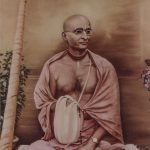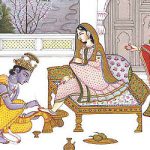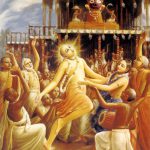 by Swami B. V. Tripurari
by Swami B. V. Tripurari
Saints tell us that Rama and Krishna are the same person. Yet Ramacandra was the personification of perfect moral character and Krishna appeared to be a cheater in some respects. To understand this apparent contradiction, we must try to understand the meaning of lila, divine play. God can be moral or immoral in appearance, yet whatever he does is absolute good. Conversely, the moral realm is not absolute: an act that is immoral in one instance may be moral in another. Morality is the means to check the evil of exploitation arising from material attachment. If we have no such attachment, then we cannot act immorally. Such is the position of Krishna, and of Rama as well.
While Rama lila emphasizes morality, Krishna lila emphasizes the possibility of life beyond the reach of morality. It is important to be moral, but it is also important to know that moral life in and of itself is not the zenith of spiritual pursuit and that the apparent immorality of Krishna is something different altogether. Caitanya Mahaprabhu was a perfect sannyasi, moral to the nth degree, yet he meditated constantly on Krishna’s apparently immoral affairs with the Vraja gopis. In doing so, he himself was never involved in extramarital affairs. Indeed, he exhibited the morality of Rama, both as perfect householder and later as a perfect sannyasi.
Rama is a maryada purusa, a perfectly dharmic (moral) lover. He draws this from Balarama, who is the maryada purusa in Krishna’s life and is Krishna’s immediate expansion from whom all other expansions and avataras issue. Balarama is one of Krishna’s gurus. At the behest of Yasoda’s vatsalya bhakti, he makes an effort to see that Krishna behaves properly. Still, he does not interfere with Krishna’s parakiya rendezvous with Radha, which highlights the sacred, not inappropriate, nature of such meetings. But Balarama himself is not directly involved in Krishna’s parakiya rasa, and his lila with his gopis is a maryada-lila. In Prince Ramacandra we find this maryada to the extreme: he vowed to have only one wife—eka patni vrata—at a time when it was common for monarchs to have harems. Ramacandra embodies the entirety of Balarama’s maryada, while the other qualities of Balarama are not fully present in him.
Within this maryada is Rama’s love for his devotees and their love for him. Thus it is not ordinary maryada. Although this love is contained in a form of moral appropriateness, it burns brightly in rasananda (sacred aesthetic rapture) beneath the surface. Laksmana’s sakhya rasa with Rama is most touching. Even while the better part of Rama’s lila involves the search for Sita, it is Laksmana’s sakhya and more so Hanuman’s dasya that stand out. The supporting roles of Laksmana and especially Hanuman are most compelling, and Valmiki develops them beautifully. The entrance to Rama lila is in dasya bhakti, and thus for all spiritually practical purposes it is Hanuman who is the most important figure in Ramayana. This dasya bhakti, realized by the grace of Rama nama, is what we find in the heart of Valmiki Rsi.
Although the sacred aesthetic rapture between Rama and his bhaktas is the heart of Rama lila, such bhakti-rasa cannot be developed to its peak of spiritual eroticism within his lila. When Ramacandra passed through the Dandakaranya forest, the sages residing there in meditation desired to become his devotees in the emotion of transcendental eroticism. However, Ramacandra informed them that in this incarnation he was not able to fulfill their desire because he had taken a vow to have only one wife. He then told them that they could only attain this devotional status in relation to his appearance as Krishna.
As for sakhya, in Rama lila we find that the sakhya of Laksmana is not allowed to fully blossom because he is the younger brother of Rama and therefore lacks the equality that is central to sakhya rasa. The revered Krsnadasa Kaviraja therefore writes that Laksmana vowed never to take birth again as the younger brother. Consequently, as Balarama in Krishna lila he is the older brother of Ramanuja—Krishna. He is just enough older that he can assume the role of an elder at times, but the actual difference in age is negligible—so negligible that Balarama and Krishna are really equals in friendship, formalities aside. Indeed, despite the dasya and vatsalya aspects of Balarama’s love for Krishna, it is he who is Krishna’s best friend. He is the example, the very deity of brotherly love. Because he presides over vatsalya, sakhya, and dasya, we find a touch of parental love and that of a servant, but it is his sakhya that stands out. In Krishna lila he has full freedom—visrambha, pranaya—while as Laksmana in Rama lila he had to acquiesce to the sometimes unpalatable, dutiful commands of Ramacandra. Thus if our heart calls for sakhya or, more so, madhurya rasa, we must go to Krishna lila, and that through Sri Caitanya and Nityananda.
Rama lila draws us beyond Vaikuntha by speaking to us of the possibility of sakhya, vatsalya, and madhurya, even while it does not afford us those opportunities itself. In this way, it indirectly points to Krishna lila while directly offering the prospect of the dasya bhakti of Hanuman to the humanlike majesty of Rama. The realm of service to Rama is distinct from the Vaikuntha of Narayana, where the prospect is daysa bhakti to the majestic four-armed Godhead. There we find dasya and only the slightest hint of sakhya—gaurava-sakhya, friendship in awe and veneration—and no hint of proper friendship, parental, or romantic love. The hint of these possibilities comes in Rama lila, and in Sri Caitanya we find the dutifulness of Rama, even as Sri Caitanya is preoccupied with tasting and distributing the love of that great cheater, Gopijana-vallabha.










